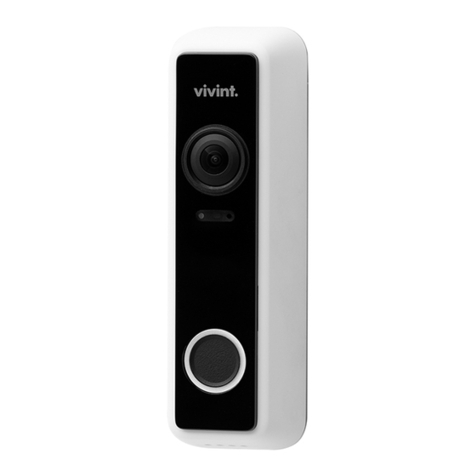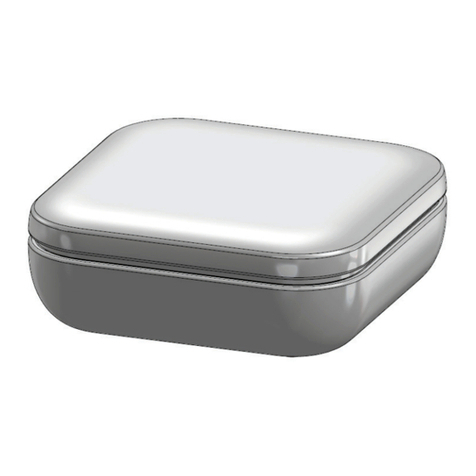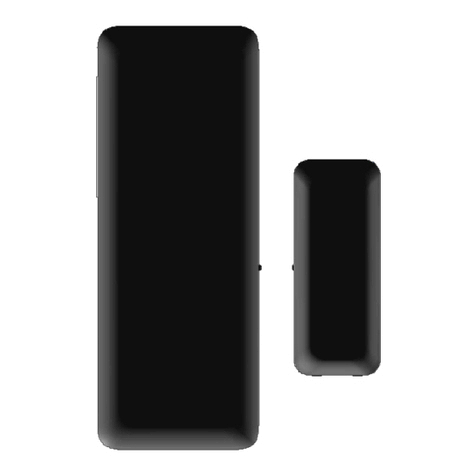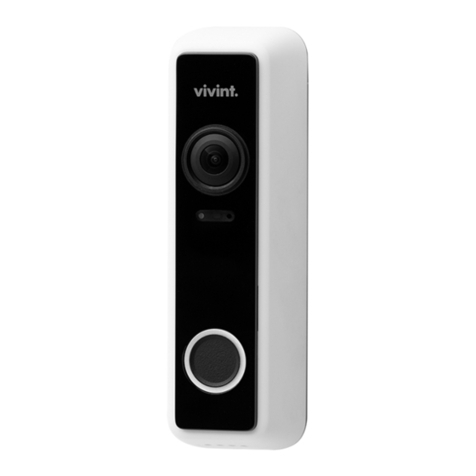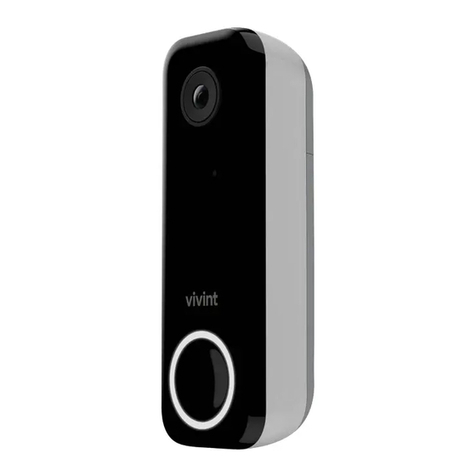Vivint VS-PIR3-345 User manual

Quick Reference
4931 N 300 W Provo, UT 84604
The
Vivint Passive Infrared Motion Sensor (PIR3) is a wall-mounted wireless device that provides wide-angle
motion detection
as part of the overall Vivint security system. The sensor device can be mounted on a flat
wall
or in a corner.
When set to
high sensitivity, the motion sensor has a maximum protection area of 40 feet (12.2 m) deep by 50
feet
(15.2 m) wide. For best coverage possible, mount the sensor so that the most likely direction of intruder
motion is
across the protected area.
The
PIR3 sensor is tamper-protected; it will transmit a signal to the control panel/hub if the cover is taken off
or if the
device is removed from its mounting location. It also provides false alarm protection by being pet
immune
for animals up to 80 pounds (36.3 kg). For more information, see the "Settings for Pet Immunity"
section below.
This document includes
a product description, installation and test instructions, illustrations, basic operation /
user functionality,
as well as technical specifications, standards listings, and regulatory compliance references.
Installation Instructions
The
Vivint Motion Sensor can be installed on a flat wall or in a 90-degree corner.
To
install the sensor, follow these steps:
1. Attach the back mounting plate to the wall 7.5 feet (2.3 m) above the floor with
the arrows pointing up.
NOTE: To mount on a flat wall, secure the back plate by using the two provided
screws in the center holes. To mount in a corner, secure the back plate by using
the two screws in the side holes.
2. Secure the sensor on to the back plate by sliding it down until it clicks into place.
INSTALLATION TIPS:
•Mount so that the likely direction of intruder motion is across the protected area.
•Use High sensitivity when it is anticipated an intruder may only cover a small
portion of the protected area.
•Low
sensitivity is recommended for settings with pets when intruders are expected
to cover a larger portion of the protected area.
•Do not install where the detector is exposed to direct sunlight or above strong
sources of heat.
•Ensure the detection area does not have obstructions (curtains, screens, large
pieces of furniture, plants, etc.) that may block the coverage pattern.
•Avoid mounting locations that contain objects likely to produce a rapid change in
temperature such as central heating, ducts, open flames, etc.
•If mounting in a hallway, the best location is at the end of the hallway in a corner
facing directly down the hallway (not at the typical 45-degree angle).
•
If pet immunity is desired, mount where animals cannot come within six feet of the
detectors by climbing on furniture or other objects. Also, do not aim the detector
at a stairway or furniture or other objects that can be climbed by an animal.
Installer / User Test
1. Press and hold the test button on the side of the sensor device. The red LED should turn
on as soon as the button is pressed. After 2 seconds, the red LED will blink once to
indicate the device has entered test mode.
2. The red LED will briefly turn on every few seconds that motion is detected. The PIR3
will
also transmit to the control panel/hub while motion is detected. NOTE: Test mode lasts
for 90 seconds, after which the device returns to normal operation.
Technical / Hardware Specifications
Vivint Part Number (P/N)
VS-PIR3-345
Model Number (M/N)
MD01
Wireless Signal Range
350 feet (106.7 m), open air
Batteries
2 X Panasonic CR123A or equivalent lithium batteries
Battery Life
3-5 years under normal usage
Transmitter Frequency
345 MHz
Code Outputs
Alarm, Alarm Restore, Supervisory, Low Battery,
Tamper
Supervisory Interval
70 minutes per signal (12 hours for panel/hub to report
supervision failure)
Operating Temp. Limits
32° to 120°F (0° to 49°C)
Relative Humidity
5-95% Non-Condensing
Motion
Sensor
(V
S-PIR3-345)
PRINT INSTRUCTIONS:
REFERENCE SHEET FOR VS-PIR3-345, P/N 77-600049-001 REV 1.0 |
INK: BLACK | MATERIAL: 20 LBMEAD BOND | SIZE: 8.50" X 11.00" SCALE 1:1 |
FOLDS: BI-FOLD VERTICAL, BI-FOLD HORIZONTAL (TO FIT IN BOX)
Back Mounting Plate (inside view) —
Motion Sensor (back view open) —
Standards Certifications and Listings
UL 639 Standard for Intrusion Detection Units
ULC Subject S306
Standard for Intrusion Detection Units
FCC ID: 2AAAS-MD01
IC:
10941A-MD01
*For complete regulatory compliance
i
nformation, go to: vivint.com/fcc.

Battery Installation
If the battery is low, a low battery notification will be indicated on the panel. Use only the recommended replacement batter
ies (see Specifications). To replace the batteries:
1. Slide the main body of the PIR2 up off the back plate (part A).
2. Pull battery ribbon to remove batteries.
3. Insert the replacement batteries while observing the correct polarity. Ensure the battery ribbon runs up underneath the batteries so they can easily be removed.
FCC and ISED Canada Regulatory Compliance Declarations*
CAUTION!
Unauthorized changes or modifications could void the user’s authority to operate the equipment.
This device has been tested and found to comply with the limits for a Class B digital
device, pursuant to Part 15 of FCC Rules and Industry Canada license-
exempt RSS standard(s). Operation is subject to the
following two conditions:
(1) This device may not cause harmful interference, and
(2) This device must accept any interference received, including interference that may cause undesired operation of the device.
These limits are designed to provide reasonable protection against harmful interference in a residential installation. This e
quipment generates, uses, and can radiate radio frequency energy and, if not
installed and used in accordance with the instructions, may cause harmful interference to radio communications. However, ther
e is no guarantee that interference will not occur in a particular installation.
If this equipment does cause
harmful interference to radio or television reception, which can be determined by turning the equipment off and on, the user is encouraged to try to correct the interference
by one or more of the following measures:
•Reorient or relocate the receiving antenna.
•Increase the separation between the equipment and the receiver.
•Connect the equipment into an outlet on a circuit different from that to which the receiver is connected.
•Consult the dealer or an experienced radio/television technician for help.
PRU
DENCE!Changements ou modifications pourraient annuler le droit de l'utilisateur à utiliser l'équipement non autorisées.
Conformément à la réglementation d'Industrie Canada, le présent émetteur radio peut fonctionner avec une antenne d'un type et
d'un gain maximal (ou inférieur) approuvé pour l'émetteur par Industrie
Canada. Dans le but de réduire les risques de brouillage radioélectrique à l'intention des autres utilisateurs, il faut chois
ir le type d'antenne et son gain de sorte que la puissance isotrope rayonnée
équivalente (p.i.r.e.) ne dépasse pas l'intensité nécessaire à l'établissement d'une communication satisfaisante.
Le présent appareil est conforme aux CNR d’Industrie Canada applicables aux appareils radio exempts de licence. L’exploitatio
n est autorisée aux deux conditions suivantes:
(1) l’appareil ne doit pas produire de brouillage, et
(2) l’utilisateur de l’appareil doit accepter tout brouillage radioélectrique subi, même si le brouillage est susceptible d’en compromettre le fonctionnement.
Ces
limites sont conçues pour fournir une protection raisonnable contre les interférences nuisibles dans une installation résidentielle. Cet équipement génère, utilise et peut émettre une énergie de
radiofréquence et, s'il n'est pas installé et utilisé confor
mément aux instructions, il peut causer des interférences nuisibles aux communications radio. Cependant, il n'existe aucune garantie que des
interférences no se produiront pas dans une installation particulière. Si cet équipement provoque des interférences
nuisibles à la réception radio ou télévision, ce qui peut être déterminé en mettant
l'équipement hors et sous tension, l'utilisateur est encouragé à essayer de corriger l'interférence par une ou plusieurs des
mesures suivantes:
•Réorienter ou déplacer l'antenne de réception.
•Augmentez la distance entre l'équipement et le récepteur.
•Connecter l'équipement à une sortie sur un circuit différent de celui sur lequel le récepteur est branché.
•Consulter le revendeur ou un technicien radio / télévision expérimenté pour de l'aid.
WARNING! The polarity of the battery must be observed (as shown in the image). Improper handling of lithium batteries may result in heat generation, explosion, or fire, which may lead to
personal injury. Replace only with the same or equivalent battery type as recommended by the manufacturer.
AVERTISSEMENT! La polarité de la batterie doit être observée (comme indiqué dans l'image). Une mauvaise manipulation des piles au lithium peut conduire à la production de chaleur, une
explosion ou un incendie, ce qui peut entraîner des blessures. Remplacez-le par le même type ou équivalent de la batterie tel que recommandé par le fabricant.
Batteries must not be recharged, disassembled or disposed of in fire.
Disposal of used batteries must be made in accordance with the waste recovery and recycling regulations in your area. Keep away
from small children. If batteries are swallowed, promptly see a doctor.
© 2022 Vivint Inc. All Rights Reserved.|www.vivint.com |1-800-216-5232 | Device M/N: MD01| Doc P/N: 77-600049-001 Rev. 1.0
Wireless Product Notice
Wireless communications hardware provides reliable communication; however, there are some limitations which must be observed.
•The transmitters are required to comply with all applicable wireless rules and regulations. As such, they have limited transmitter power and limited range.
•Wireless signals may be blocked by radio signals that occur on or near the wireless operating frequencies.
Settings for Pet Immunity
Small Pet
Immunity:
Used where small animals may be present in the monitored area while the
system is
armed. Do not use this setting if any given animal weighs more
than 40 pounds
(18.1 kg). On this setting, the coverage area is 50 feet (
15.2
m
) wide by 40 feet deep (12.2 m). NOTE:Set the jumper to small pet icon.
Large Pet
Immunity:
Used in
environments where larger animals may be present. This setting is
generally acceptable for animals up to 80 pounds
(36.3 kg). On this setting,
the coverage area is 20 f
eet (6.1 m) wide by 20 feet (6.1 m) deep. (Note:
Set the jumper to the large
pet icon.)
NOTE: Many factors can influence pet immunity capabilities:
•Short-haired animals generally put off more heat causing the
detector to alarm easier than it would with a longer-haired animal.
•If animals jump onto a piece of furniture or climb stairs it may
cause the detector to believe the animal is larger than it really is.
•If multiple animals are close together the sensor may see them as
one large animal.
Sensitivity
Settings:
High — recommended when a possible intruder is expected to cover
only a small portion of the protected area. (Set the jumper to HI.)
Low —
recommended when a possible intruder is expected to cover a
larger portion of the protected area, and/or to help reduce false
alarms when pets are present. (Set the jumper to LO.)
Other Vivint Accessories manuals
